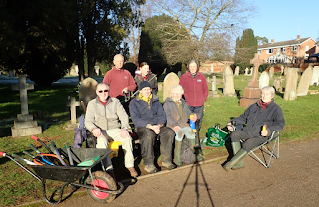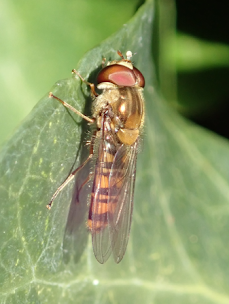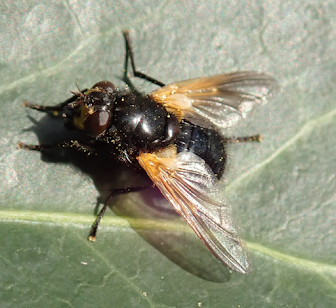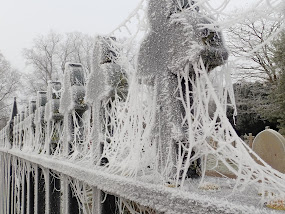Hitchin Cemetery October to December 2022
Having been inspected by an assessor earlier in the year, in October the Friends of Hitchin Cemetery were delighted to receive an award recognising their work for the community and the environment from the Council for the Protection of Rural England. This helps us spread the word that the cemetery is an important asset to the Hitchin area. (Apologies to Hilary who is missing from the Friends photo).
The final months of the year are still busy one for the volunteers with lots of jobs to do, tending graves and borders and especially hedge trimming now that the bird nesting season is well and truly finished. This year the bushes are a little easier to cut as we now have our very own hedge trimmer paid for by the developers of the Bethel Court houses. We have more of the developers grant left over to spend on tools, bird boxes and bat boxes which we look forward to installing over the coming months.
Autumn interest in the cemetery included deciduous trees turning colour and some smaller plants in flower. Shown below is the unusual member of the Chestnut family, the Carolina Buckeye and some delicate Cyclamen.
The tiny moths known as leaf miners whose caterpillars are small enough to live between the top and bottom surfaces of a leaf can be found in the cemetery. Autumn is a good time of year to search for these creatures and there are dozens of species to be found if you know where to look. Shown below are just two examples: a Rose Leaf Miner which makes a winding corridor and favours Wild Roses rather than garden types and a Firethorn Leaf Miner which is found on both Pyracantha bushes and London Plane trees (as in the cemetery) making a long thin blotch.


The unimproved grassland of the cemetery is an important habitat for fungi and although there do not seem to be as many around as in previous years (may be due to the hot dry summer?) there were still some interesting ones to see. There were some Parrot Waxcaps which start green and gradually turn yellow with age, these are a good indicator species suggesting that the cemetery grassland is especially good for wildlife. A Shaggy Parasol was looking quite smart with its scaley cap


Lichens are composite organisms made up of an algae living within a fungal structure and just about every gravestone in the older parts of the cemetery has them. My friend Paula (a Lichen expert) has told me it is not unusual for a cemetery to have 100 different types of lichen and so in southern England, where the landscape does not have much exposed stone, cemeteries are an important habitat for lichens. One grave had what appeared to be some tiny dark dried up leaves but Paula tells me is actually a perfectly healthy Dog Lichen (below left) and on the same grave was a Pixie-cup lichen with little columns which may go on to produce spores from the fungal part of the lichen if conditions are right.
There are lichens which favour sunny spots, ones that favour shady spots, some which prefer particular wood or stone types and even ones which specialise in using the nutrients from bird droppings.
There were still some insects flying in November, and on warmer days right throughout winter there will probably be some to be found basking in any little sun traps. Within five minutes I noted four different types of fly on the Ivy near the Fire Station, three are Hoverflies: Eupeodes (no common name), Batman and Marmalade and finally the Noon Fly with orange wings, but as I write this in mid-December we are in the middle of a very cold snap and any warm days may be a while coming.
In mid-December the heavy frosts encouraged many people to take photos of the white conditions and there were huge numbers of usually near-invisible spider's webs which could be seen all along the railings. Then the snow came the many Silver Birches were especially pretty.
Finally, a pleasant treat before Christmas for the Friends group was donated by a kind neighbour who came to thank us for our work with some Mulled Wine and a card, much appreciated!
PS Contrary to what I had previously thought, my sighting from earlier in the year of a little sawfly caterpillar Gilpinia frutetorum was actually confirmed by an expert & this makes it only one of about a dozen or so sightings ever recorded in the UK, so an exciting addition to the list of cemetery wildlife.




















Comments
Post a Comment